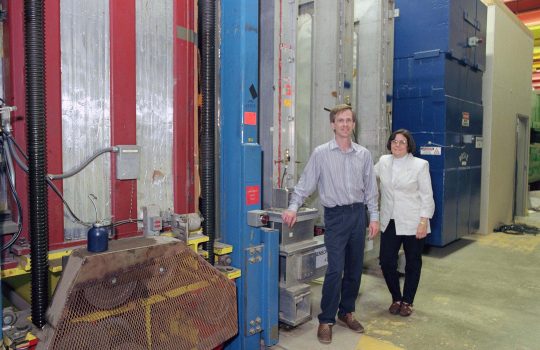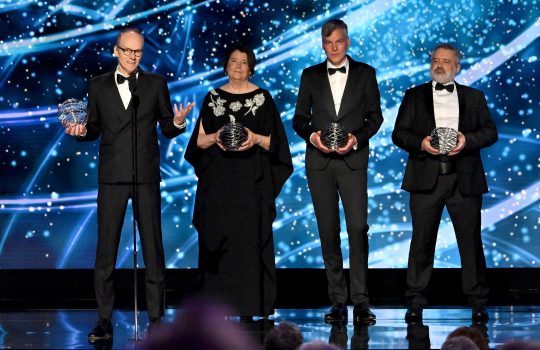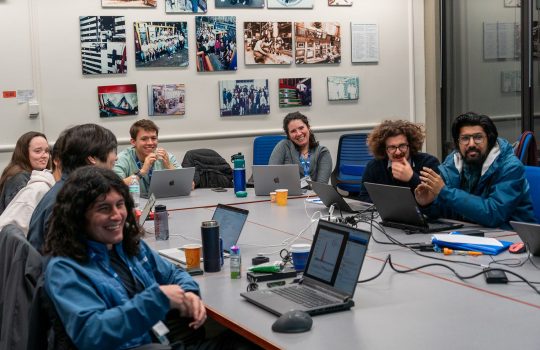After an unexpected measurement by the Collider Detector at Fermilab (CDF) experiment in 2022, physicists on the Compact Muon Solenoid experiment at the Large Hadron Collider announced today a new mass measurement of the W boson, one of nature’s force-carrying particles. This new measurement, which is a first for the CMS experiment, uses a new technique that makes it the most elaborate investigation of the W boson’s mass to date. Following nearly a decade of analysis, CMS has found that the W boson’s mass is consistent with predictions, finally putting a multi-year long mystery to rest. View the paper.
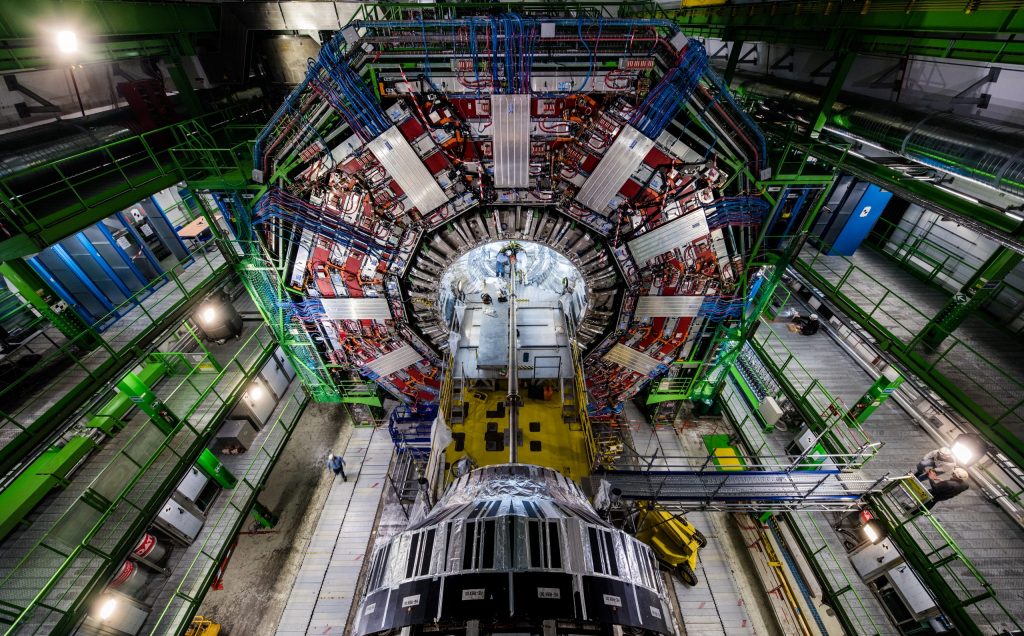
The Compact Muon Solenoid detector is located 100 meters underground on the Franco-Swiss borderer at CERN and collects data from the Large Hadron Collider. The detector has been operational since 2010 and is used by one of largest international scientific collaborations in history to study the fundamental laws of nature. Photo: Brice, Maximilien: CERN
The final analysis used 300 million events collected from the 2016 run of the LHC, and 4 billion simulated events. From this dataset, the team reconstructed and then measured the mass from more than 100 million W bosons. They found that the W boson’s mass is 80 360.2 ± 9.9 megaelectron volts (MeV), which is consistent with the Standard Model’s predictions of 80 357 ± 6 MeV. They also ran a separate analysis that cross-checks the theoretical assumptions.
“The new CMS result is unique because of its precision and the way we determined the uncertainties,” said Patty McBride, a distinguished scientist at the U.S. Department of Energy’s Fermi National Research Laboratory and the former CMS spokesperson. “We’ve learned a lot from CDF and the other experiments who have worked on the W boson mass question. We are standing on their shoulders, and this is one of the reasons why we are able to take this study a big step forward.”
Since the W boson was discovered in 1983, physicists on 10 different experiments have measured its mass.
The W boson is one of the cornerstones of the Standard Model, the theoretical framework that describes nature at its most fundamental level. A precise understanding of the W boson’s mass allows scientists to map the interplay of particles and forces, including the strength of the Higgs field and merger of electromagnetism with the weak force, which is responsible for radioactive decay.
“The entire universe is a delicate balancing act,” said Anadi Canepa, deputy spokesperson of the CMS experiment and a senior scientist at Fermilab. “If the W mass is different from what we expect, there could be new particles or forces at play.”
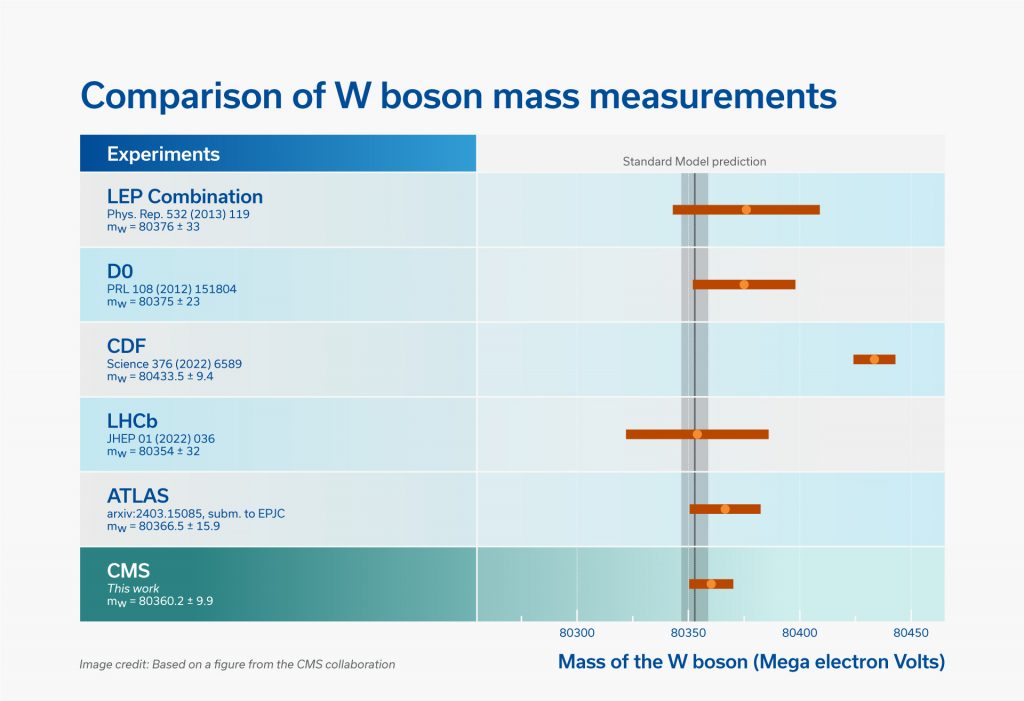
Comparison measurements of the W boson’s mass with other experiments and the Standard Model prediction. The dot is the measured value and length of the line corresponds to the precision; the shorter the line, the more precise the measurement. Image based on a figure produced by the CMS collaboration. Created by Samantha Koch, Fermilab
The new CMS measurement has a precision of 0.01%. This level of precision corresponds to measuring a 4-inch-long pencil to between 3.9996 and 4.0004 inches. But unlike pencils, the W boson is a fundamental particle with no physical volume and a mass that is less than a single atom of silver.
“This measurement is extremely difficult to make,” Canepa added. “We need multiple measurements from multiple experiments to cross-check the value.”
The CMS experiment is unique from the other experiments that have made this measurement because of its compact design, specialized sensors for fundamental particles called muons and an extremely strong solenoid magnet that bends the trajectories of charged particles as they move through the detector.
“CMS’s design makes it particularly well-suited for precision mass measurements,” McBride said. “It’s a next generation experiment.”
Because most fundamental particles are incredibly short-lived, scientists measure their masses by adding up the masses and momenta of everything they decay into. This method works well for particles like the Z boson, a cousin of the W boson, which decays into two muons. But the W boson poses a big challenge because one of its decay products is a tiny fundamental particle called a neutrino.
“Neutrinos are notoriously difficult to measure,” said Josh Bendavid, a scientist at the Massachusetts Institute of Technology who worked on this analysis. “In collider experiments, the neutrino goes undetected, so we can only work with half the picture.”
Working with just half the picture means that the physicists need to be creative. Before running the analysis on real experimental data, the scientists first simulated billions of LHC collisions.
“In some cases, we even had to model small deformations in the detector,” Bendavid said. “The precision is high enough that we care about small twists and bends; even if they’re as small as the width of a human hair.”
Physicists also need numerous theoretical inputs, such as what is happening inside the protons when they collide, how the W boson is produced, and how it moves before it decays.
“It’s a real art to figure out the impact of theory inputs,” McBride said.
In the past, physicists used the Z boson as a stand-in for the W boson while calibrating their theoretical models. While this method has many advantages, it also adds a layer of uncertainty into the process.
“Z and W bosons are siblings, but not twins,” said Elisabetta Manca, a researcher at the University of California Los Angeles and one of the analyzers. “Physicists need to make a few assumptions when extrapolating from the Z to the W, and these assumptions are still under discussion.”
To reduce this uncertainty, CMS researchers developed a novel analysis technique that uses only real W boson data to constrain the theoretical inputs.
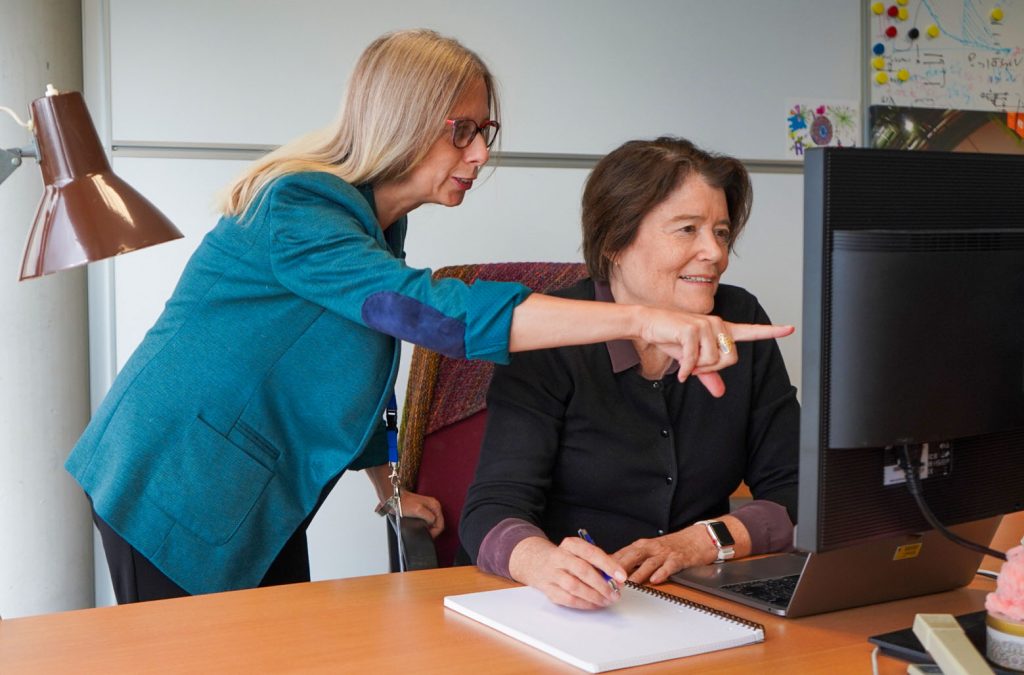
Anadi Canepa, deputy spokesperson of the CMS experiment and a senior scientist at Fermilab, and Patty McBride, a distinguished scientist at Fermilab and the former CMS spokesperson, are leaders within the CMS collaboration and have worked closely with the analysis team since 2022.
Photo: Saskia Theresa Rodriguez, CERN
“We were able to do this effectively thanks to a combination of a larger data set, the experience we gained from an earlier W boson study, and the latest theoretical developments,” Bendavid said. “This has allowed us to free ourselves from the Z boson as our reference point.”
As part of this analysis, they also examined 100 million tracks from the decays of well-known particles to recalibrate a massive section of the CMS detector until it was an order of magnitude more precise.
“This new level of precision will allow us to tackle critical measurements, such as those involving the W, Z and Higgs bosons, with enhanced accuracy,” Manca said.
The most challenging part of the analysis was its time intensiveness, since it required creating a novel analysis technique and developing an incredibly deep understanding of the CMS detector.
“I started this research as a summer student, and now I’m in my third year as a postdoc,” Manca said. “It’s a marathon, not a sprint.”
The Compact Muon Solenoid (CMS) experiment is funded in part by the Department of Energy’s Office of Science and the National Science Foundation. It is one of two large general-purpose experiments at the Large Hadron Collider (LHC) at CERN, the European Particle Physics Laboratory.
Fermilab is the host laboratory in the U.S. that facilitates the participation of hundreds of USCMS physicists from more than 50 university groups and plays a leading role in detector construction and operations, computing and software, and data analysis.
Fermi National Accelerator Laboratory is supported by the Office of Science of the U.S. Department of Energy. The Office of Science is the single largest supporter of basic research in the physical sciences in the United States and is working to address some of the most pressing challenges of our time. For more information, please visit science.energy.gov.

